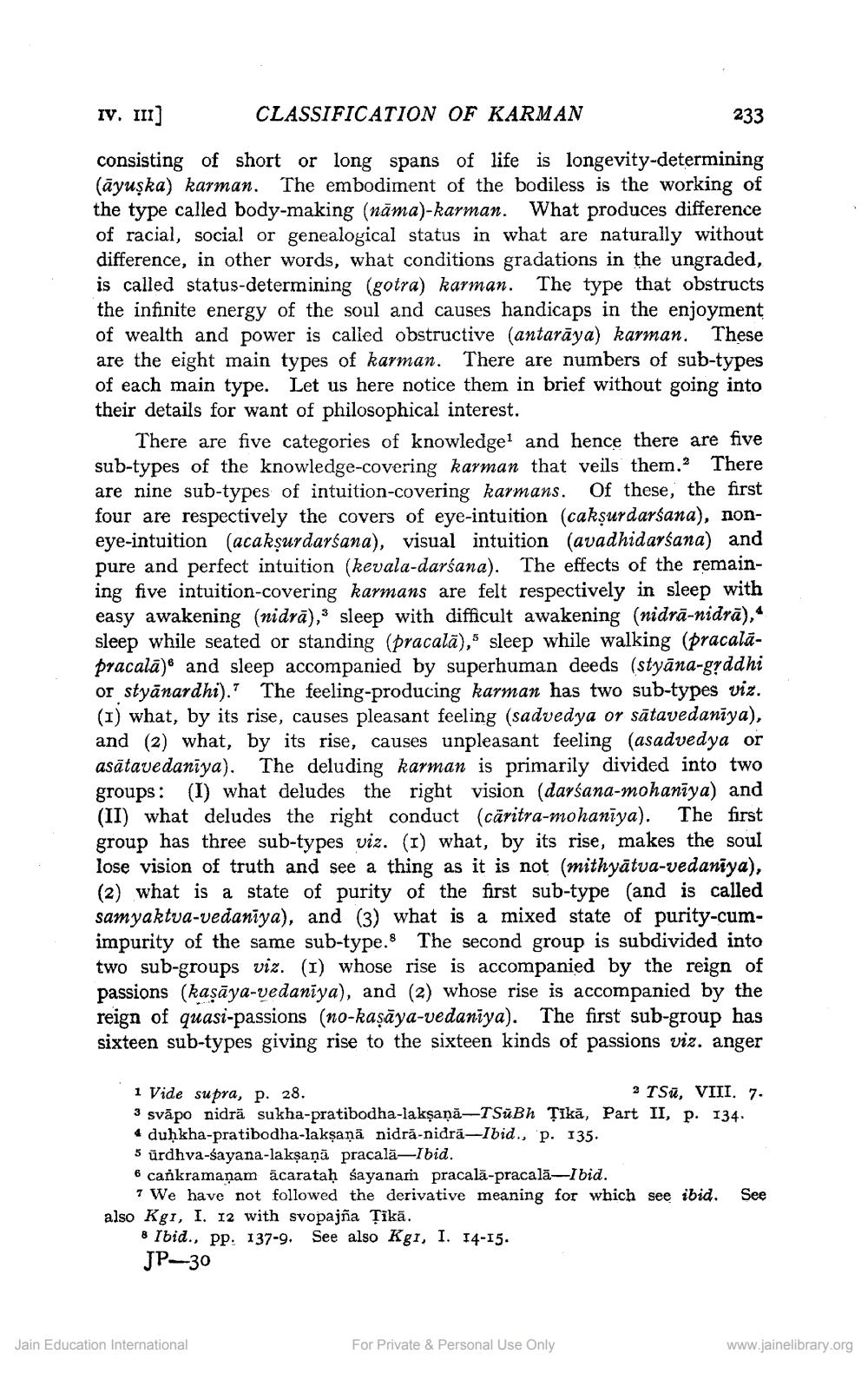________________
IV. III]
CLASSIFICATION OF KARMAN
233
consisting of short or long spans of life is longevity-determining (āyuşka) karman. The embodiment of the bodiless is the working of the type called body-making (nāma)-karman. What produces difference of racial, social or genealogical status in what are naturally without difference, in other words, what conditions gradations in the ungraded, is called status-determining (gotra) karman. The type that obstructs the infinite energy of the soul and causes handicaps in the enjoyment of wealth and power is called obstructive (antarāya) karman. These are the eight main types of karman. There are numbers of sub-types of each main type. Let us here notice them in brief without going into their details for want of philosophical interest.
There are five categories of knowledge and hence there are five sub-types of the knowledge-covering karman that veils them. There are nine sub-types of intuition-covering karmans. Of these, the first four are respectively the covers of eye-intuition (cakşurdarśana), noneye-intuition (acakşurdarśana), visual intuition (avadhidarśana) and pure and perfect intuition (kevala-darśana). The effects of the remaining five intuition-covering karmans are felt respectively in sleep with easy awakening (nidrā),% sleep with difficult awakening (nidrā-nidrā), sleep while seated or standing (pracalā),5 sleep while walking (pracalāpracalā) and sleep accompanied by superhuman deeds (styāna-gyddhi or styānardhi). The feeling-producing karman has two sub-types viz. (1) what, by its rise, causes pleasant feeling (sadvedya or sātavedaniya), and (2) what, by its rise, causes unpleasant feeling (asadvedya or asātavedaniya). The deluding karman is primarily divided into two groups: (I) what deludes the right vision (darśana-mohanīya) and (II) what deludes the right conduct (căritra-mohaniya). The first group has three sub-types viz. (I) what, by its rise, makes the soul lose vision of truth and see a thing as it is not (mithyātva-vedaniya), (2) what is a state of purity of the first sub-type (and is called samyaktva-vedaniya), and (3) what is a mixed state of purity-cumimpurity of the same sub-type. The second group is subdivided into two sub-groups viz. (I) whose rise is accompanied by the reign of passions (kasāya-vedaniya), and (2) whose rise is accompanied by the reign of quasi-passions (no-kaṣāya-vedaniya). The first sub-group has sixteen sub-types giving rise to the sixteen kinds of passions viz. anger
1 Vide supra, p. 28.
2 TSU, VIII. 7. 3 svāpo nidrā sukha-pratibodha-lakşaņā-TSūBh Țikā, Part II, p. 134. 4 duḥkha-pratibodha-laksana nidra-nidrā-Ibid., p. 135. 5 urdhva-sayana-lakşaņā pracalā-Ibid. 6 cankramaņam ācarataḥ sayanam pracalā-pracală-Ibid.
7 We have not followed the derivative meaning for which see ibid. See also Kgi, I. 12 with svopajña Țīkā.
8 Ibid., pp. 137-9. See also Kgr, I. 14-15. JP-30
Jain Education International
For Private & Personal Use Only
www.jainelibrary.org




